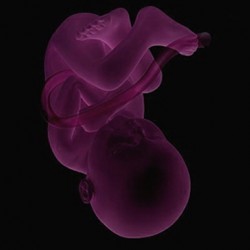By Helen Figueira
August 15, 2011
Time to read: 4 minutes
 Gestation affects adult liver fat
Gestation affects adult liver fat
Around two hundred and sixty babies are born every minute in the world, more than twenty-four of these prematurely (WHO). Around one in every ten births worldwide occurs preterm (before 33 weeks). Most of these (85%) are concentrated in Africa and Asia, while improvements to healthcare in developed nations gives preterm infants a much greater chance of survival.
Gestation affects adult liver fat
Around two hundred and sixty babies are born every minute in the world, more than twenty-four of these prematurely (WHO). Around one in every ten births worldwide occurs preterm (before 33 weeks). Most of these (85%) are concentrated in Africa and Asia, while improvements to healthcare in developed nations gives preterm infants a much greater chance of survival.
However, this does not come without a price, as researchers at the MRC Clinical Sciences Centre – led by Professor Jimmy Bell (Metabolic and Molecular Imaging Group) – are starting to discover. A few years ago the team spotted something unusual about preterm babies. They had significantly more abdominal fat – particularly around the liver – than infants born at term (37-42 weeks).
The implications of this finding are as yet unclear, although fatty-liver is a risk factor for type 2 diabetes and insulin resistance. The team wanted to know whether this was simply a temporal difference, so they looked at adults (aged 18-27), and were surprised to find the same thing: much higher liver fat in preterm individuals – especially in males – than those born at term.
In the UK most people with a fatty liver are overweight or obese, but the preterm and term individuals in this study were healthy young adults. “Most of them were students and had very similar lifestyles and socio-economic backgrounds,” explains Jimmy Bell. “Both groups had similar lifestyles, food consumption and physical activity levels.”
“So when we started this study, I really didn’t expect to find such a marked phenotype.” Earlier research by Barker (Pubmed) and others has shown that early-life programming is critical to what happens in adulthood, “but this is one of the few examples of an early-life programming phenotype, which is sustained through to adulthood,” Jimmy reveals.
“Clearly events happening early on have modulated the way their [preterm group] bodies function in relation to fat.” The team speculates that there is some sort of uterine cue during the first few weeks of life that does not fully happen in preterm individuals. “Perhaps certain genes in the liver don’t get switched on properly in preterm subjects.”
“What the long-term effects are, we don’t know at the moment,” Jimmy adds, “but we do know that higher levels of liver fat pose a stronger risk of developing insulin-resistant and type 2 diabetes.” With some 346 million diabetic people in the world, and around 3.5 million annual deaths caused by the consequences of the disease worldwide (WHO), isolating risk factors for disease onset is of considerable importance.
“On the positive side,” says Jimmy, “we know we can superimpose environment on genetics in most obese phenotypes.” Intervention programmes that alter lifestyle in terms of diet and physical activity can change the levels of fat in the liver. “So we now plan to impose lifestyle changes on the preterm and term groups to explore how lifestyle affects liver fat in preterm individuals.”
The team is exploring the differences at a molecular level, supplementing preliminary results with preclinical and biochemical data. “We’re looking at the genes involved in fat metabolism and beta-oxidation (the way mitochondria oxidise fat),” reveals Jimmy. “While the jury’s out on whether we can achieve this, it will provide us with the opportunity to look at the overall impact of early-life programming on body fat metabolism.”
BM
Thomas et al. (2011) Aberrant Adiposity and Ectopic Lipid Deposition Characterize the Adult Phenotype of the Preterm Infant”. Pediatr Res, July [Epub]